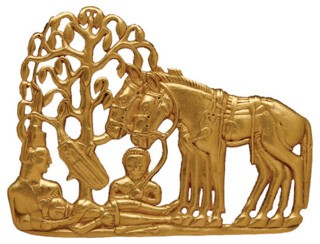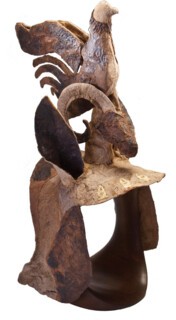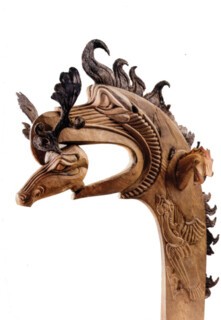Herodotus tells us that when Darius’ Persian army invaded Scythia, in the late sixth century bce, the Scythians ran away. The Persians followed them over the steppeland north of the Black Sea until, tiring of the pursuit, Darius sent a messenger to the Scythian king to tell him to make a stand or bend the knee. The Scythian king, Idanthyrsus, informed the messenger that as they had no cities or crops they had nothing to defend and could therefore afford to exhaust the Persians by making them traipse across the land. They would fight only if the Persians tried to loot their graves: ‘Attack those graves and you will soon discover whether we are fighters or not!’ Eventually, his army sickening and hungry, Darius gave up and returned to Persia.
Nomadic civilisations pose many of the same difficulties to archaeologists as they do to invading armies. They are difficult to pin down. For one thing the Scythians weren’t so much a people as some peoples. The term ‘Scythians’ is a collective name for a number of migratory tribes who spoke early Iranian dialects and enjoyed a similar lifestyle, culture, economy and set of beliefs. Between 800 bce and 300 bce, roughly speaking, these tribes roamed a vast expanse of land stretching from Central Asia in the east to the Hungarian plain in the west (an area that would include parts of south-west Russia, Ukraine and Kazakhstan today). They were wealthy, allegedly because they controlled the slave trade between Northern Europe and Greece. But being illiterate they left no manuscripts, and being nomadic no ruins. There are accounts of them written by non-Scythians, Herodotus most prominently, but a lot of what we know about them we know because the graves they were so keen to defend have been ransacked and their contents – in many cases well preserved by permafrost – brought to light.
These graves, or kurgans (their Slavic name), provided rich pickings for grave-robbers until looting them was made illegal by Peter the Great in the early 18th century. It was Peter the Great who commissioned the first archaeological excavations of Scythian tombs and his Siberian Collection, on which much of our knowledge of Scythian material culture depends, contains around 240 gold artefacts. One of the most famous pieces of Scythian art and the first exhibit in the British Museum’s current show (until 14 January 2018) is a fourth-century gold belt buckle from Peter’s collection, 16 cms wide and 12 cms tall, which depicts two men in low relief sitting with a dead comrade beneath a tree. The man on the right holds the reins of two horses while the man on the left cradles the head of his dead friend, who lies on the ground in a suit of armour looking a lot like the sculpture of a dead knight one might find on a medieval tomb. A quiver of arrows hangs from the tree. The leaves, horses’ heads and quiver all droop downwards giving the impression that the whole scene is sinking into the earth, drawn by the gravity of death.
But the mood of this piece is hardly typical. The exhibition contains several magnificent gold plaques depicting fighting animals in a more dynamic style. A tiger battles a monster with the body of a panther, the head of a wolf, a bird’s beak and antlers; it tears into the monster’s foreleg with its teeth as the monster grabs the tiger’s neck between its jaws; the monster’s muscles bulge and the tiger’s body ripples with sinew. Knots of inter-bestial violence such as this one are a common trope in Scythian art, and not only on gold plaques. One of the most impressive pieces is an elaborate headdress found at one of the many burial sites in the Pazyryk Valley in the Altai mountains. The top part of it is wooden and carved into the shape of an eagle’s head, with a long neck crested by a curly mohican. The neck rises up from the back of the wearer’s head to a height of 35 cms, closely resembling the prow of a Viking longship, and in its beak the eagle grips the head of a stag. Two more birds skirmish on the neck: one is carved in low relief, the other’s head juts out from the side of the headdress and scowls back at its antagonist. Finally, a sidepiece made of thick leather with etched detail shows a stag with outsize antlers being harassed by an eagle. It doesn’t look aerodynamic enough for war, but the catalogue entry suggests it was worn by a chieftain in his ‘final battle’.
‘Animal style’ art is considered one node in what is known as the ‘Scythian triad’ – the three items commonly found in kurgans, the others being weapons and horse gear. But the animal style, which flourished between the seventh and fourth centuries, is all over the weapons and horse gear too. The Scythians were renowned horsemen and warriors and carried bladed weapons and arrows made of iron, often with gold or silver overlays. A scabbard coated in gold leaf depicts an army of griffins marching single file along its length, some with bows and arrows, and a galloping stag on its handle; an arrowhead sports an image in gold appliqué of a vulture disturbed while eating a goat’s head. The high regard in which Scythians held their horses is attested to by bridles decorated with animals and a splendid horse’s helmet sculpted in wood with a ram’s head on top of it and a cock-like bird sitting between the ram’s horns. The show also includes fragments of the tattooed skin of chieftains excavated in Pazyryk: they had tattoos of horses on their arms, sheep and goats on their shins and cockerels on their thumbs.
These kinds of image were obviously important to the Scythians, and we know from a story Herodotus tells that they thought of animals symbolically. In the course of their diplomatic exchange the Scythians are supposed to have sent Darius a bird, a mouse, a frog and five arrows. Darius interpreted these gifts, somewhat hastily, as a declaration that the Scythians were surrendering not only ‘earth and water’ – mouse and frog respectively – but also themselves, since ‘a bird was like nothing so much as a horse’. One of his henchmen gave a more cautionary reading: ‘Unless you become birds and fly away into the sky, or become mice and burrow into the earth, or become frogs and leap into the lakes, you will never make this land home – for you will be shot down by arrows.’ A note in the exhibition suggests that the animal style may reflect a metaphysical view according to which there are three worlds: the world of birds, the world of humans and animals, and an underworld of monsters. But the exhibition says little more about Scythian myth, and whether or not the theory holds water it doesn’t get us very far. What did the different kinds of monster signify? Why are some creatures, such as stags and vultures, so much more prevalent than others? Like Darius, with no cipher to hand, we’re thrown back on speculation and educated guesswork.
One conclusion we can draw from the tattoos and animal-emblazoned regalia is that the Scythians had a refined fashion sense. Herodotus talks of the ‘pointed-hat’ Scythians, and one of the figures in the belt buckle of the men under the tree shows us what those hats might have looked like – a fez with a tall chimney coming out the top. Helpfully, we also have a female version of the headdress, found at Pazyryk. It has a wooden flat-topped base and a funnel on top. The wearer’s hair would have been shaved at the sides but left long on the crown, braided, then pulled through the funnel and wrapped in horsehair to help it stick upwards. Controversially, the exhibition reveals that not all Scythians were bearded. Herodotus described them that way and they appear as bearded on Scythian artefacts such as a beautiful golden vase moulded with tribesmen dressing wounds and stringing bows. But the bodies found in Pazyryk were all clean-shaven, and one of them was buried with a fake beard made of human hair, which is included in the exhibition. Were the Scythians ever bearded? Were bearded Scythians the same kind of people as non-bearded Scythians?
The exhibition isn’t really a portrait of a civilisation, it’s a set of clues about a vanished social ecosystem that incorporated many different cultures and spanned an enormous tract of land. The Scythians themselves were a motley crew, and they interacted with the Chinese, Greeks and Persians, as well as the sedentary tribes who inhabited the same area, and were transformed by these interactions. Contact with the Persians, for example, seems to have altered the animal style: the Altai burial sites contained representations of horned lion-griffins, a common motif in Achaemenid art, although there are no lions on the steppe. Other objects found in the tombs feature dragon motifs, which were common in Chinese art of the period, though it’s unclear who influenced whom. Around 300 bce Scythian dominance of the region came to an abrupt end, but the fire-worshipping Sarmatians who took their place, and who spoke Iranian dialects too, retained many elements of their culture. Meanwhile the motifs of Scythian art continued to make their way into the products of other cultures, seeping eventually into the art of medieval Europe. On a long enough timeline, the exhibition reminds us, all cultures flow and blend, nomadic ones especially.
Scythians can seem unlike one another. There’s a stone sculpture from the eighth century bce that was found at a kurgan in Tuva, a stylised representation of a man that looks oddly futuristic: tall, willowy and elegant, with three slashes across its head instead of a face and circles on either side of its head in place of ears. The belt around its waist contains a knife and a quiver of arrows. It’s a different kind of object from the golden plaques – but it’s unclear how much continuity we ought to expect between eighth-century Scythians in Tuva and fourth-century Scythians in Pazyryk.
Send Letters To:
The Editor
London Review of Books,
28 Little Russell Street
London, WC1A 2HN
letters@lrb.co.uk
Please include name, address, and a telephone number.




